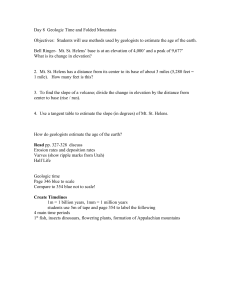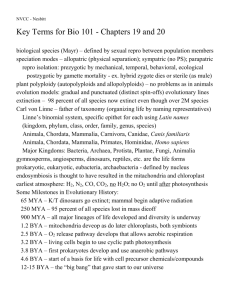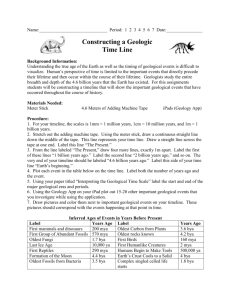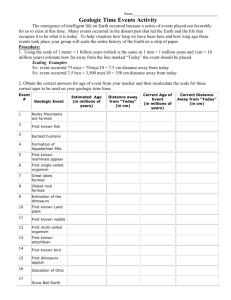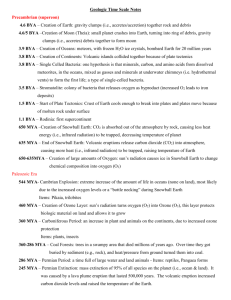Lab_Geologic_Time_Student_Sheet_filled
advertisement
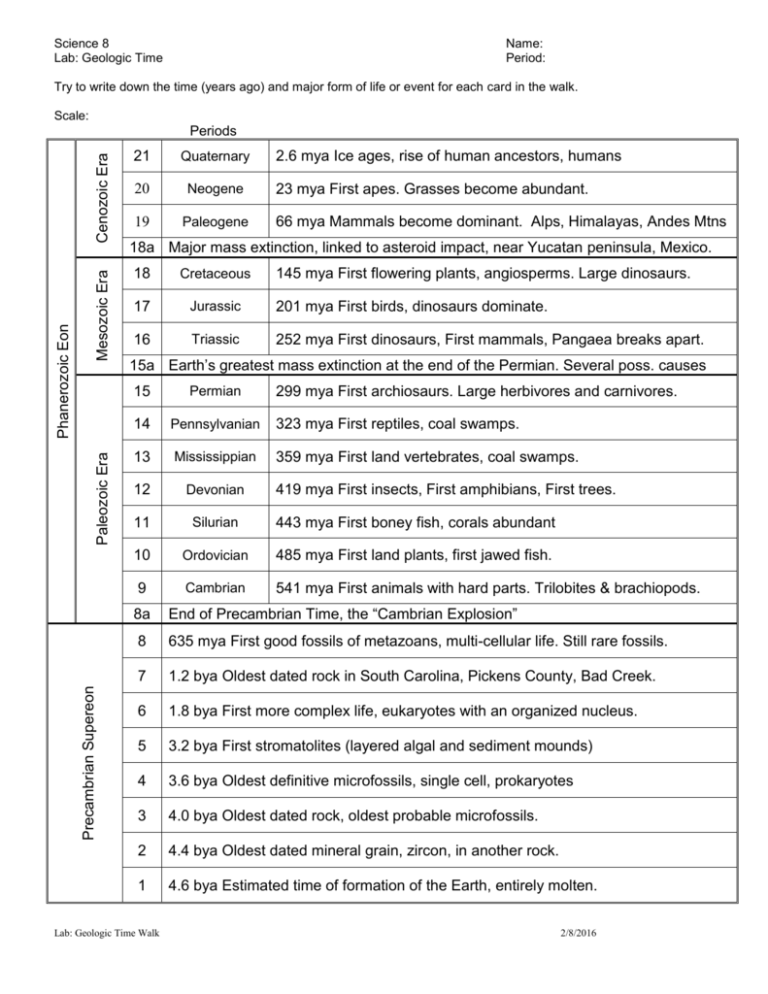
Science 8 Lab: Geologic Time Name: Period: Try to write down the time (years ago) and major form of life or event for each card in the walk. Scale: Precambrian Supereon Paleozoic Era Phanerozoic Eon Mesozoic Era Cenozoic Era Periods 21 Quaternary 20 Neogene 19 Paleogene 2.6 mya Ice ages, rise of human ancestors, humans 23 mya First apes. Grasses become abundant. 66 mya Mammals become dominant. Alps, Himalayas, Andes Mtns 18a Major mass extinction, linked to asteroid impact, near Yucatan peninsula, Mexico. 18 Cretaceous 145 mya First flowering plants, angiosperms. Large dinosaurs. 17 Jurassic 201 mya First birds, dinosaurs dominate. 16 Triassic 252 mya First dinosaurs, First mammals, Pangaea breaks apart. 15a Earth’s greatest mass extinction at the end of the Permian. Several poss. causes 15 Permian 299 mya First archiosaurs. Large herbivores and carnivores. 14 Pennsylvanian 323 mya First reptiles, coal swamps. 13 Mississippian 359 mya First land vertebrates, coal swamps. 12 Devonian 11 Silurian 443 mya First boney fish, corals abundant 10 Ordovician 485 mya First land plants, first jawed fish. 9 Cambrian 541 mya First animals with hard parts. Trilobites & brachiopods. 419 mya First insects, First amphibians, First trees. 8a End of Precambrian Time, the “Cambrian Explosion” 8 635 mya First good fossils of metazoans, multi-cellular life. Still rare fossils. 7 1.2 bya Oldest dated rock in South Carolina, Pickens County, Bad Creek. 6 1.8 bya First more complex life, eukaryotes with an organized nucleus. 5 3.2 bya First stromatolites (layered algal and sediment mounds) 4 3.6 bya Oldest definitive microfossils, single cell, prokaryotes 3 4.0 bya Oldest dated rock, oldest probable microfossils. 2 4.4 bya Oldest dated mineral grain, zircon, in another rock. 1 4.6 bya Estimated time of formation of the Earth, entirely molten. Lab: Geologic Time Walk 2/8/2016 Science 8 Lab: Geologic Time and History Name: Period: Objective: To demonstrate the length of geologic time and to aid in understanding the order of geologic and biologic events. Materials: event cards, meter stick, 10 meter length of string or rope with knots at 1 meter intervals, area for a long walk. Procedure: Using the scale of 1 meter representing 10 million years, the length of geologic time will be demonstrated with cards at the correct points to show the events in Earth’s history according to the fossil and rock record. Questions: 1. How many years does 1 decimeter (0.1 m) represent? 1 million years 2. How many years does 1 decameter (10 m) represent? 100 million years 3. How many years does 1 millimeter represent? 10,000 years 4. Which is the longest named unit of geologic time? Precambrian time 5. Which is the shortest geological era? Cenozoic Era 6. Which era do we live in? Cenozoic Era 7. Describe the length of time that humans have been on Earth compared to the length of geologic time. 200,000 years/4.600,000,000 years = 0.0000434 or 0.00434 % 8. Describe the length of time that there has been civilization on Earth compared to the length of time that the dinosaurs were on Earth. 11,000 years/186,000,000 years = 0.0000591 or 0.00591 % 9. Why do we know the most about only the last 540 million years of Earth’s history? That is when life first developed hard parts making fossilization much more likely. 10. What is the Law of Faunal Succession? The Law of Faunal Succession states that for all around the Earth in layers of undisturbed strata there is always the succession of fossils. For example, from fish to amphibians to reptiles to mammals. They never first appear all at once together or in a different order. 11. What impressions and conclusions can you draw from today’s activity? Lab: Geologic Time Walk 2/8/2016


